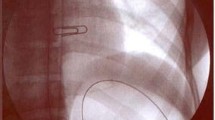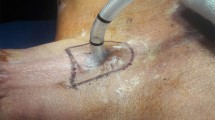Abstract
Background
Pharyngoesophageal stricture (PES) is an Achilles’ heel in the management of corrosive injury. Advances in endoscopic techniques were utilized in its management. We classified the stricture as per its dilatability and then planned their treatment.
Methods
PES was sub-categorized based on endoscopic dilatation and availability of cervical oesophagus: group-1 stricture with available cervical oesophagus; group-2 stricture with some part of upper oesophagus made available after endoscopic dilatation and anastomosis in cervico-pharyngeal area; group-3 stricture not amenable for dilatation, anastomosis done at the pharynx. Endoscopic dilatation was performed using through-the-scope pyloric balloon. Number and duration of dilatation sessions before surgery, incidence of tracheostomy, time and incidence for re-stricture and present status of swallowing were evaluated.
Results
Of 226 patients managed, 46 underwent oesophageal replacement for PES. Group 1, 2 and 3 had 12, 14 and 20 patients, respectively. An average 3 (2–4) preoperative balloon dilatation sessions were performed over 6–8 weeks. Tracheostomy was required in 1, 0, 8 patients (p = 0.010), and median hospital stay was 10, 9 and 13 days (p = 0.09) in group 1, 2, 3, respectively. Re-stricture developed in 4/12, 4/14, 9/20 patients with average sessions of dilatation required in post-operative period was 4, 3.5 and 8 in group 1, 2, 3, respectively. >90% of patients are taking normal diet in each group.
Conclusion
We attempted to avoid the high anastomosis by dilating the PES and step down the level of anastomosis in two-third patients. We thereby avoided tracheostomy, aspiration and swallowing problems related to high strictures.




Similar content being viewed by others
References
Ananthakrishnan N, Kate V, Parthasarathy G (2011) Therapeutic options for management of pharyngoesophageal corrosive strictures. J Gastrointest Surg 15:566–575
Guha G, Gupta S, Chakraborty S (2005) Pharyngo oesophageal strictures and its reconstruction by deltopectoral flaps. Indian J Otolaryngol Head Neck Surg 57(3):229–234
Kim JH, Song HY, Kim HC et al (2008) Corrosive esophageal strictures: long-term effectiveness of balloon dilation in 117 patients. J Vasc Interv Radiol 19(5):736–741
Youn BJ, Kim WS, Cheon J-E et al (2010) Balloon dilatation for corrosive esophageal strictures in children: radiologic and clinical outcomes. Korean J Radiol 11:203–210
Tettey M, Edwin F, Aniteye E et al (2011) Colopharyngoplasty for intractable caustic pharyngoesophageal strictures in an indigenous African community—adverse impact of concomitant tracheostomy on outcome. Interact CardioVasc Thorac Surg 12:213–217
Peters JH, Meester TR, Stein HJ (1995) Surgical therapy for cancer of the esophagus and cardia. In: Castell DO (ed) The esophagus, 2nd edn. Little, Brown, New York, pp 293–335
Knezevic JD, Radovanovic NS, Simic AP et al (2007) Colon interposition in the treatment of esophageal caustic strictures: 40 years of experience. Dis Esophagus 20(6):530–534
Piotet E, Escher A, Monnier P (2008) Esophageal and pharyngeal strictures: report on 1,862 endoscopic dilatations using the Savary-Gilliard technique. Eur Arch Otorhinolaryngol 265:357–364
Contini S, Scarpignato C (2013) Caustic injury of the upper gastrointestinal tract: a comprehensive review. World J Gastroenterol 19(25):3918–3930
Ananthakrishnan N, Parthasarathy G, Maroju NK et al (2007) Sternocleidomastoid muscle myocutaneous flap for corrosive pharyngoesophageal strictures. World J Surg 31:1592–1596. doi:10.1007/s00268-007-9120-5
Ananthakrishnan N, Nachiappan M, Subba Rao KS (2001) Island pectoralis major myocutaneous flap for pharyngo-oesophageal strictures prior to oesphagocoloplasty. J R Coll Surg Edinb 46(4):202–204
Hsieh MH, Yang YT, Tsai YJ, Kuo YR, Lin PY (2016) Comparison of the outcomes of free jejunal flap reconstructions of pharyngoesophageal defects in hypopharyngeal cancer and corrosive injury patients. Microsurgery. doi:10.1002/micr.30135
Lee HS, Park SY, Jang HJ, Kim MS, Lee JM, Zo JI (2012) Free jejunal graft for esophageal reconstruction using end-to-side vascular anastomosis and extended pharyngo-jejunostomy. Ann Thorac Surg 93(6):1850–1854
Wu M-H, Tseng Y-L, Lin M-Y et al (2001) Esophageal reconstruction for hypopharyngoesophageal strictures after corrosive injury. Eur J Cardiothorac Surg 19:400–405
Moradi P, Glass GE, Atherton DD, Eccles S, Coffey M, Majithia A, Speirs AJ, Clarke PM, Wood SH (2010) Reconstruction of pharyngolaryngectomy defects using the jejunal free flap: a 10-year experience from a single reconstructive center. Plast Reconstr Surg 126(6):1960–1966
Yannopoulos P, Lytras D, Paraskevas KI (2006) Esophageal reconstruction with intraoperative dilatation of the hypopharynx for the management of chronic corrosive esophageal strictures. A technical tip. Eur J Cardiothorac Surg 30(6):940–942 (Epub 2006 Oct 17)
Huang J, Xiao Y, Cheng B, Wang T (2009) Laryngotracheal canal for hypopharyngoesophageal stricture after corrosive injury. Int J Surg 7:114–119
Vimalraj V, Rajendran S, Jyotibasu D et al (2007) Role of retrograde dilatation in the management of pharyngo-esophageal corrosive strictures. Dis Esophagus 20:328–332
Jiang YG, Lin YD, Wang RW et al (2005) Pharyngocolonic anastomosis for esophageal reconstruction in corrosive esophageal stricture. Ann Thorac Surg 79:1890–1894
Acknowledgements
Sundeep S Saluja, Vaibhav K Varshney and P K Mishra contributed in the keeping the data, preparation of manuscript and involved in the management of the patients. Siddharth Srivastava and Pritul Saxena involved in endoscopic management both pre- and post-operatively. Ravi Meher performed hypopharyngoscopy of all patients, adhesiolysis, if needed and involved in patient management.
Author information
Authors and Affiliations
Corresponding author
Ethics declarations
Conflict of interest
The authors declare no conflict of interest.
Rights and permissions
About this article
Cite this article
Saluja, S.S., Varshney, V.K., Mishra, P.K. et al. Step-Down Approach for Pharyngoesophageal Corrosive Stricture: Outcome and Analysis. World J Surg 41, 2053–2061 (2017). https://doi.org/10.1007/s00268-017-3966-y
Published:
Issue Date:
DOI: https://doi.org/10.1007/s00268-017-3966-y




